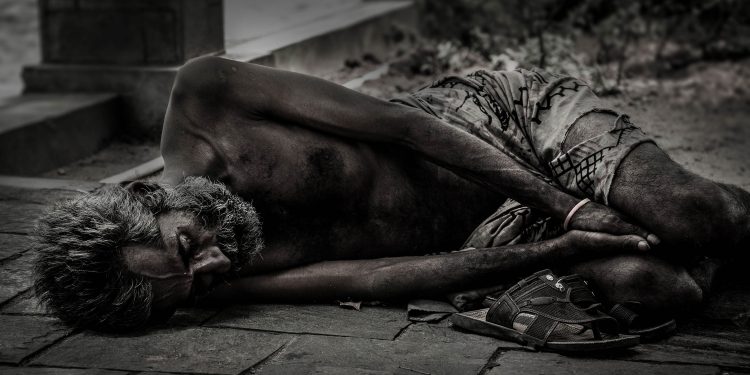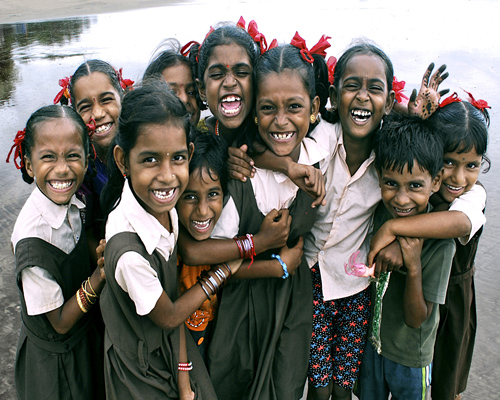Kis Aadhaar Se?

Starvation In The Indian Context
India is a country with a population of over 1.3 billion. The population increases at the rate of 1.2% per year, making us the second most populated country in the world. Incidentally, the Indian food industry is the world’s sixth largest and is expected to increase by three times by 2020. How then, one wonders, are 197 million people in India undernourished? How do 7000 people die every day in India because of lack of food? How does India rank at a shameful 97 out of 118 in the Global Hunger Index? The Nobel laureate Amartya Sen aptly explains this phenomenon in his seminal work Poverty and Famines: An Essay on Entitlement and Deprivation as he writes, “Starvation is the characteristic of some people not having enough food to eat. It is not a characteristic of there not being enough to eat.” For the past seven decades, we have developed phenomenally in all aspects and fields – agriculture, industry, applied and natural sciences as well as information technology. We aspire to be an industrial and commercial superpower in the world by 2025. It is therefore surprising as well as disheartening when we see the statistics of hunger in India – 1 in 4 children in rural India is undernourished; India is home to the largest malnourished population in the world and 3000 children die in India from poor diet-related illness.
Why Aadhaar ?
Recently, the death of 10-year-old Santoshi Kumar in Bimdega district of Jharkhand due to starvation came to light. Her family was denied rations because their ration card was not linked to their Aadhaar card. The whole country was shaken by this death, as she is said to have been begging for rice even in her last breath. Hardly a month later, the death of Badinath Ravidas, a 40-year-old rickshaw puller from the district of Jharia was reportedly for the same reasons, as his family was denied rations from the government’s public distribution system. Incidents like these compel us to take a step back and scrutinize our government and its policies. The Centre had announced linking of Aadhaar cards to PAN cards, phone numbers, bank accounts, ration cards and other government documents. This is known as the Aadhaar-based biometric authentication. Though the government strictly declared the deadline for linking Aadhaar cards to these documents, they glossed over the part where they had to make proper arrangements for it to be implemented in rural areas. Proper implementation seems to be an issue the present government should take more seriously than it does. In addition to linking their Aadhaar cards to their ration cards, the beneficiaries have to authenticate their biometrics at PDS shops to avail food. This is easier said than done. This two-step procedure is marred by technical glitches like biometrics malfunctioning which has led the poor to lose their legal entitlement to subsidized rations as mentioned under the National Food Security Act, 2013. Systemic failures such as computers that record biometric fingerprints not working and officialdom rampant across the state do not make it easier for the underprivileged. However, it is not just technical failures that this system must fix. The active role of middlemen who demand superfluous amounts of money from the deprived under the pretext of acquiring Aadhaar cards for them is preventing a large chunk of the society from availing their guaranteed benefits. Ownership of food is a primary right and government has legitimised this right through rules. Denial of food is thus a result of the failure of this legal entitlement.
The Government’s Role
The Jharkhand government ‘deeply regretted’ the deaths of Santoshi and Bajinath. The Unique Identification Authority of India (UIDAI) said that the deceased’s family did have an Aadhaar card and yet they were denied food. The government has said that those responsible will be punished. However, the government fails to see the bigger picture which is lack of proper implementation of the Aadhaar linking scheme. While the motive of this action taken by the government is undoubtedly good, they need to realize that economically disadvantaged people cannot manage to do the necessary in such a short period of time. Historically oppressed and disenfranchised lower castes and tribal populations are the poorest of the poor and they are the worst hit. Aadhaar linked welfare schemes are excluding these groups and the PDS system is the worst hit. The system in place for the Aadhaar-based biometric authentication for PDS requires multiple complex technologies to work at the same time – the PoS machine, the biometrics, the internet connection and often the local mobile network. While this plan sounds very systematic and proper, it is completely inappropriate for rural India, where people do not even get electricity for days together. On the road to development, the government has missed out on the part where they have to equip villages and small towns with appropriate technologies to carry out the procedures. Even those for whom the system works face huge inconvenience. They have to make repeated trips to the PDS shop until the machine cooperates. In rural India, this is a recipe for chaos. Jean Dreze points out that due to these failures, the people are not able to get their due. Aadhaar is a legal instrument, however, it cannot prevent people from accessing food that they rightfully deserve. Once it starts doing that, the issue ceases to be legal and becomes ethical. The only thing that stands between availability of food and entitlement to food is the law. Right to food is not merely a legality, it is an ethical and moral issue. Starvation deaths can reflect legality with a vengeance.



